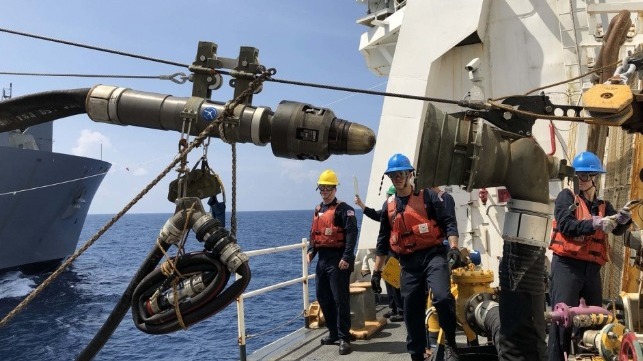U.S. Navy, Coast Guard Focus Joint Strategy on Chinese Expansionism

The U.S. Navy, Marine Corps and Coast Guard have released a joint strategy outline oriented towards countering Chinese expansionism in the Western Pacific. It reiterates Navy and Marine Corps' doctrine and force structure goals - like distributing capability across a large number of smaller, cheaper, potentially unmanned platforms - and adds in an overseas presence and law enforcement role for the U.S. Coast Guard. It also recognizes the need to recapitalize the civilian-operated sealift fleet to sustain go-anywhere dominance on the high seas.
"Since the beginning of the 21st century, our three Sea Services have watched with alarm the growing naval power of the People’s Republic of China and the increasingly aggressive behavior of the Russian Federation," wrote the three services' top officers in a joint statement. "Optimism that China and Russia might become responsible leaders contributing to global security has given way to recognition that they are determined rivals. The People’s Republic of China represents the most pressing, long-term strategic threat."
The strategy recognizes China's growing sea power and warns that without rapid development of a "modernized, integrated all-domain naval force," the Navy may no longer be able to guarantee the security of America's maritime interests. "The boldness of our actions must match the magnitude of our moment. The security of our nation depends on our ability to maintain advantage at sea," wrote Marine Corps Commandant Gen. David Berger, Chief of Naval Operations Adm. Michael Gilday and Coast Guard Commandant Karl Schultz.
The strategy recognizes China's multipronged approach to eroding American power at sea - undermining international maritime law, cutting off access to logistics hubs, controlling the use of key choke points, and displacing the U.S. as the partner of choice in developing coastal nations. China uses a large, multi-layered military and (nominally) civilian fleet to accomplish its goals, including PLA Navy, China Coast Guard and "maritime militia" fishing vessels, deployed for presence and coercion operations short of war. China already has the world's largest naval force, and it is investing heavily in growing and modernizing it with new cutters, surface combatants and submarines. Through the Belt and Road initiative, it is also building out civilian port infrastructure in overseas nations, which can be repurposed for naval sustainment.
"China is the only rival with the combined economic and military potential to present a long-term, comprehensive challenge to the United States," the services warned. "Naval Service operations and force posture will focus on countering PRC malign behavior globally and strengthening regional deterrence in the Indo-Pacific region."
The near-term effort to counter Chinese influence centers on deterring "incrementalism" - the "salami-slicing" strategy employed by Chinese forces to gradually assert control over contested areas. "Deterring and contesting incrementalism requires firm and persuasive operations to confront malign behavior. Ready, forward-deployed naval forces will accept calculated tactical risks and adopt a more assertive posture in our day-to-day operations," the services wrote.
The U.S. Coast Guard plays a role in this effort by enforcing the rule of law - conducting freedom of navigation operations to challenge illegal maritime claims, combating illegal fishing and transnational crime with its boarding and law enforcement capabilities, and enforcing sanctions through maritime interdiction operations. "Coast Guard forces provide additional tools for crisis management through capabilities that can de-escalate maritime standoffs nonlethally," according to the strategy.
Sustainment
This forward-deployed deterrence and warfighting capability depends on a robust logistics system. Without a regular resupply of jet fuel, a nuclear-powered carrier cannot generate fighter sorties, and without bunkering, a destroyer or cruiser cannot provide air defense or pursue an anti-submarine or anti-surface mission. Ground forces cannot sustain operations for extended periods without regular resupply of ammunition and spare parts.
To address the shortcomings of the aging U.S. logistics fleet, the plan calls for accelerating the sealift recapitalization strategy for the prepositioning fleet and the Ready Reserve Force. This includes "increased resourcing for sealift operations, maintaining service life extensions, and prioritizing the efficient replacement of the oldest and least ready vessels."
It also calls for cooperation with the Department of Transportation and the Maritime Administration to "foster a healthy commercial maritime industry that can more effectively support force mobilizations."
